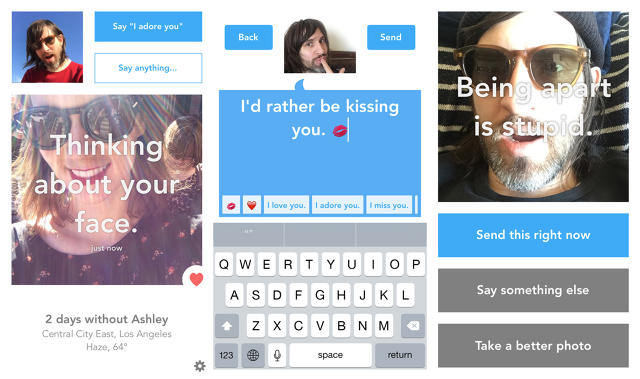with out Will save Your long-Distance Relationship (Or attempt to, at the least)
The app makes it more straightforward to keep in touch together with your far flung sweetheart.
July 27, 2015
“You’re advertising this mistaken,” a without consumer lately wrote to the app’s founder, Jeremy Schoenherr. “This app isn’t simply excellent for long-distance relationships; it’s excellent for all relationships.” The consumer could also be right, however Schoenherr feels rather confident about without’s audience—these in committed, long-distance relationships—as a result of these are people like him.
In spring of 2014, the 39-12 months-outdated developer’s female friend was once offered her dream job in l. a.. at the time, the couple had been residing collectively in NY city for four years; within every week, she was on the opposite side of the us of a. “We had our routines and existence,” says Schoenherr. “All of that was once disrupted.” They took turns journeying each and every other each few weeks, but in between, Schoenherr—who received an Apple Design Award for his work on major League Baseball’s app, MLB At Bat, and has considering that worked with the staff-texting app GroupMe—discovered himself longing now not just for her, but in addition for an more straightforward method to simply check in. “There was nothing that might let someone comprehend you were fascinated with them,” he says. Schoenherr checked out that gap (both in the market and in his day) and began to fill it with code.

“I couldn’t substitute actual face to face to communication—it’s arduous to indicate affection with an app. I was once hoping to copy that kind of interaction as best possible as I may from 2,000 miles away,” he says. “the easiest way I may try this was once by using reducing the amount of time that it took to get your notion out. You’re passing your associate’s favourite restaurant, however you don’t want to kind, ‘saw this and it made me bring to mind you.’”
as a substitute, you open with out, with its selfie-prepared homescreen and take a quick shot in front of the loved café. with out routinely attaches notes like “I pass over you” (you can customize these) to pictures. With a single tap, which you could ship your partner a visual and textual replace—what customers have taken to calling “a without.” “There isn’t much overhead in expressing, ‘thinking of you’ or ‘i really like you’” or other sentiments couples are likely to share, says Schoenherr. due to the fact that launching in February of 2015, the self-funded app has garnered 6,000 registered users and just lately surpassed 100,000 notes sent.
Why now not simply use facebook Messenger, Snapchat, WhatsApp, or simple previous texting? “the non-public side is singular amongst purposes; there’s just one one that shares the app with you,” says Fran, 26, a instrument developer in big apple, who met her boyfriend 9 months ago in his residence united states of america of Argentina. “It’s your individual little chatroom that nobody else may also be part of.”
“In many ways it solves the problem of doing one thing smartly,” says Oliver, a 40 12 months-old most cancers researcher who, five months in the past, took a job throughout the Atlantic ocean from his accomplice of two-and-a-1/2 years. Organizing the logistics of their home back in Europe, in addition to her eventual transfer to join him, Oliver and his partner have been repeatedly leaping from side to side between Skype, iMessage, and the other communication apps. “It was once good having a separate channel just for ‘hi there, i love you,’” Oliver says. “That channel will have been the rest, however i like this as a result of it’s very centered. It doesn’t do anything but. It’s a very deliberate partnering: I simply considered you. I wasn’t just hanging out in WhatsApp and saw you.” When customers talk about with out, “They call it ‘our’ app,” says Schoenherr. “It’s something that belongs to the relationship, as opposed to Snapchat, which is a platform for communicating with somebody you might recognize.”

additionally, the prospect of humiliating your self with a misdirected message decreases dramatically with with out. “There’s no chance I’ll ship a smiley face to my boss,” says Oliver, (an emoji misfortune which has befallen him more than once over textual content). As for the most personal of messages, customers have been divided. “It’s just right at evening, for romantic stuff, too,” stated Isabel, a 27-12 months-outdated human resources supervisor in Spain. no longer a lot for Mara, a 35-year outdated winemaker in South Africa whose important other lives within the Bay space. “Lol . . . GROSS . . . NO,” she wrote in an e mail.
Schoenherr surely failed to design the app with that in mind. What surprises Schoenherr is what number of of with out’s customers—roughly 20%—have been the usage of the app regardless of now not being long distance. It has an attraction to folks in relationships whose jobs and households make nice calls for of their time, especially armed forces couples, as well as these clingy pairs who don’t wish to feel apart for any size of time at all.
This last team brings one very beneficial demographic to mind: children, specifically high school and faculty students. Theirs can also be relationships at their most excessive—the place communication is frenetic and obsessive, and selfies are ubiquitous (and could neatly use with out’s protections; in contrast to texting, there is not any history, no photos saved—if any individual steals or hacks your phone, all they’ll get from without is the last picture you bought).

“youthful individuals will love this,” says Schoenherr, who just lately modified the minimal age to obtain the app from 17-plus to 12-plus in the Apple retailer. “You are living with your oldsters; whoever you’re with is across city. I remember that being on the telephone for hours and hours.” whereas his supposed market isn’t high schoolers, he can see it trickling down to that age team, naturally, from school-age users.
For now, he’s persevering with to direct the app’s attentions to long-distance couples, and, with some notes from his customers, making improvements to the present options. the focal point for Schoenherr is on balancing ease of use, the app’s cornerstone, with more options. the next model will will let you send a stack of pictures, not simply separately, and for the longer term, he’s making an allowance for gifs. movies and archiving functionality aren’t currently on the agenda.
without, of course, isn’t for each couple—now not even necessarily ones that find it irresistible. “We’re not precisely romantic, however the app did make us say ‘I leave out you’ way more than we have ever mentioned previously,” said Mara. “It used to be enjoyable, however it would be better suitable to people who find themselves approach mushier.” So be it—there are many those.
quick company , learn Full Story
(115)












